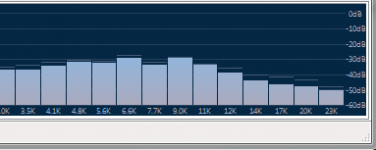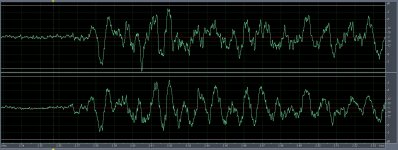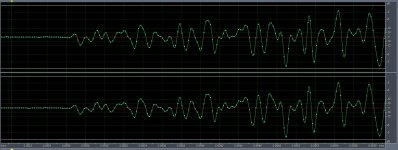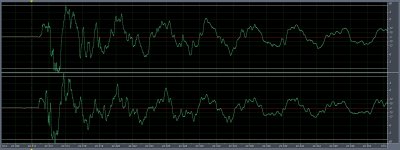Interesting link, thanksLast time I checked GoldWave's sample rate convertor was sheer crap. That is almost a way to ensure that differences will be heard.
If one aims to test the hypothesis that a sample rate above 44.1kHz is required then one should at the very least employ only the best possible SRCs.
SRC Comparisons
Yes the old version of Goldwave is pretty dire thats for sure, with the newer version a lot better but still not great.
Interesting that the free Audacity (version 1.39 in "best" mode) is one of the best performers on that comparison site with what looks like an almost exemplary result. (If I'm interpreting the graphs correctly)
Given that its free it could be a good choice for doing sample rate comparisons (at least casual ones) as long as the same version and quality mode is used...
Edit: eac3to and Final CD 0.12 are even better performers, and its scary just how downright awful some software is at doing sample rate conversion. A few in that test don't even seem to do any low pass filtering before decimation!
Last edited:
In foobar2000 I use SOX SRC (that I posted the link to), not the default SRC that was tested.
Interesting is that this free software does a great job, based on the above tests:
Interesting is that this free software does a great job, based on the above tests:
Do your own files if you have a decent ADC in your soundcard. There are some rumors that many "HD" files sold online might be just up-converted CD files.
Use the SoX-based upsampler in foobar (set to linear phase), performs way better than the standard one.
If you don't have a good ADC, use samples from here: http://www.2l.no/hires/index.html
Use the SoX-based upsampler in foobar (set to linear phase), performs way better than the standard one.
If you don't have a good ADC, use samples from here: http://www.2l.no/hires/index.html
Last edited:
I think they are more than rumors. I've seen some web page where spectral analysis showing a very sharp low-pass filter at ~20kHz was shown.There are some rumors that many "HD" files sold online might be just up-converted CD files.
At the time there was no digital
So increase sampling 8X relative to what?
No need for ABX, I can't even hear a difference between A&B (on phones).Will do some more listening this weekend with other equipment.
What's the particular DAC chip in your soundcard?
Just to continue the debate - I took an Alison Krause and Robert Plant 24/96 track I had and used Audacity to resample it to 16/44.1 No need for ABX, I can't even hear a difference between A&B (on phones).Will do some more listening this weekend with other equipment.
I've also seen some of those files in my own analysis. Some had even been MP3s at some point, by the sound of them.
The files I chose for ABX where real 24/96 files (I checked). Tho the Krause-Plant track has some strange artifacts.
Err... OK ... was about to ask ....
The Krause-Plant track is one I bought from some HD site. I'm puzzled by it, tho. RightMark shows that it has content above 20KHz, but Audacity does not. Why?
Also found something funny with Goldwave. If a file is resampled downwall, there is no stonewall filter at 1/2 the sample frequency. There appears to be if down sampled in Audacity.
Hmmmmm.......
Also found something funny with Goldwave. If a file is resampled downwall, there is no stonewall filter at 1/2 the sample frequency. There appears to be if down sampled in Audacity.
Hmmmmm.......
This page?I think they are more than rumors. I've seen some web page where spectral analysis showing a very sharp low-pass filter at ~20kHz was shown.
Scandal Brewing in High Resolution Downloads? | Computer Audiophile
I don't trust RMAA too much anymore. Open the file in foobar2000. Activate the "Spectrum" in the bottom panel.The Krause-Plant track is one I bought from some HD site. I'm puzzled by it, tho. RightMark shows that it has content above 20KHz, but Audacity does not. Why?
This is what "Hells Bells" begginging does (quick PrintScrn from LP to 24@96k).
But witout a good DAC and some good headphones is unlikelly you will notice something. You didn't say what you have. I have now E-MU1820 and Grado SR60i (for PC).
Attachments
Last edited:
So increase sampling 8X relative to what?
the 44k in the Sony white paper, 2 years before CD players were released.
dave
the 44k in the Sony white paper, 2 years before CD players were released.
I was first acquainted with the theory of PCM at uni around the same time. So - what insight did I miss?
no, it wasn't on CA. I remember it had thumbnails of the spectrograms.This page?
anyway since we touched on the transients issue a bit I thought about adding some waveform screen shots of percussive instruments. I'm not sure everyone looked at least once. I'm attaching a .zip containing the respective sounds so you can get an idea. kettle drum, tom and some unknown metal percussion instrument, all off audiophile recordings. the samples are ~1s each so I don't think I'm breaking any copyright. as you can see there's no "step-function"-like portion as some might believe. the reason "metal" is zoomed in more is that is has more high-frequency content (hitting metal object). "kettle" and "tom" are zoomed out so what looks like very sharp transients actually spans on many samples, you can see the different X-axis units. I selected these off tracks where the respective instruments are played independently (no other sounds except decay tails from previous note) so that the rise from silence is more obvious.
Attachments
Last edited:
Good question. Try a third program as a tie breakerThe Krause-Plant track is one I bought from some HD site. I'm puzzled by it, tho. RightMark shows that it has content above 20KHz, but Audacity does not. Why?
By the way I've downloaded "high res" 96Khz/24bit audio samples from a few of the websites that are selling them and looked at them in spectralab, (using digital loopback when playing on a 96Khz/24bit sound card) and some of the sample downloads clearly had genuine content above 22Khz which gradually tapered off to about 30-35Khz or so, (so must have been high sample rate right through the recording chain) while other samples from the exact same site had very obvious brick wall filters just above 20Khz with no supersonic content at all which means the content was clearly up-sampled from 44Khz. (I smell a bit of a scam...)
If you have a look at the SRC site linked on the previous page and choose the older version of goldwave (5.18 ?) then look at the "transition response" you'll see that it does not apply a brick wall filter before downsampling, thus generates massive amounts of aliasing products if there were any supersonic frequencies.Also found something funny with Goldwave. If a file is resampled downwall, there is no stonewall filter at 1/2 the sample frequency. There appears to be if down sampled in Audacity.
Hmmmmm.......
In the case of an actual recording with genuine supersonic content (like one of the ones I downloaded) this would fold down very audibly into the audible spectrum
As I mentioned in a previous post whilst Audacity 1.39 in best mode isn't the best on the test page it does still score pretty highly and has a good brickwall filter. I would rather believe Audacity over Goldwave...
Edit: even the new version of Goldwave shows a lot more aliasing of supersonic content than Audacity.
Last edited:
Thanks Simon. Got a suggestion for a third software to look at spectrum? Anyone?
I'd really like to know how much, if any, content there is above 20Khz before I make A/B judgments.
Then how does one determine that a file is truly 24 bit, and hasn't been expanded from 16 bit?
I have Goldwave 5.23. and Audacity 1.3(Beta)
I'd really like to know how much, if any, content there is above 20Khz before I make A/B judgments.
Then how does one determine that a file is truly 24 bit, and hasn't been expanded from 16 bit?
I have Goldwave 5.23. and Audacity 1.3(Beta)
- Status
- This old topic is closed. If you want to reopen this topic, contact a moderator using the "Report Post" button.
- Home
- General Interest
- Everything Else
- "24/192 Music downloads, and why they make no sense"




